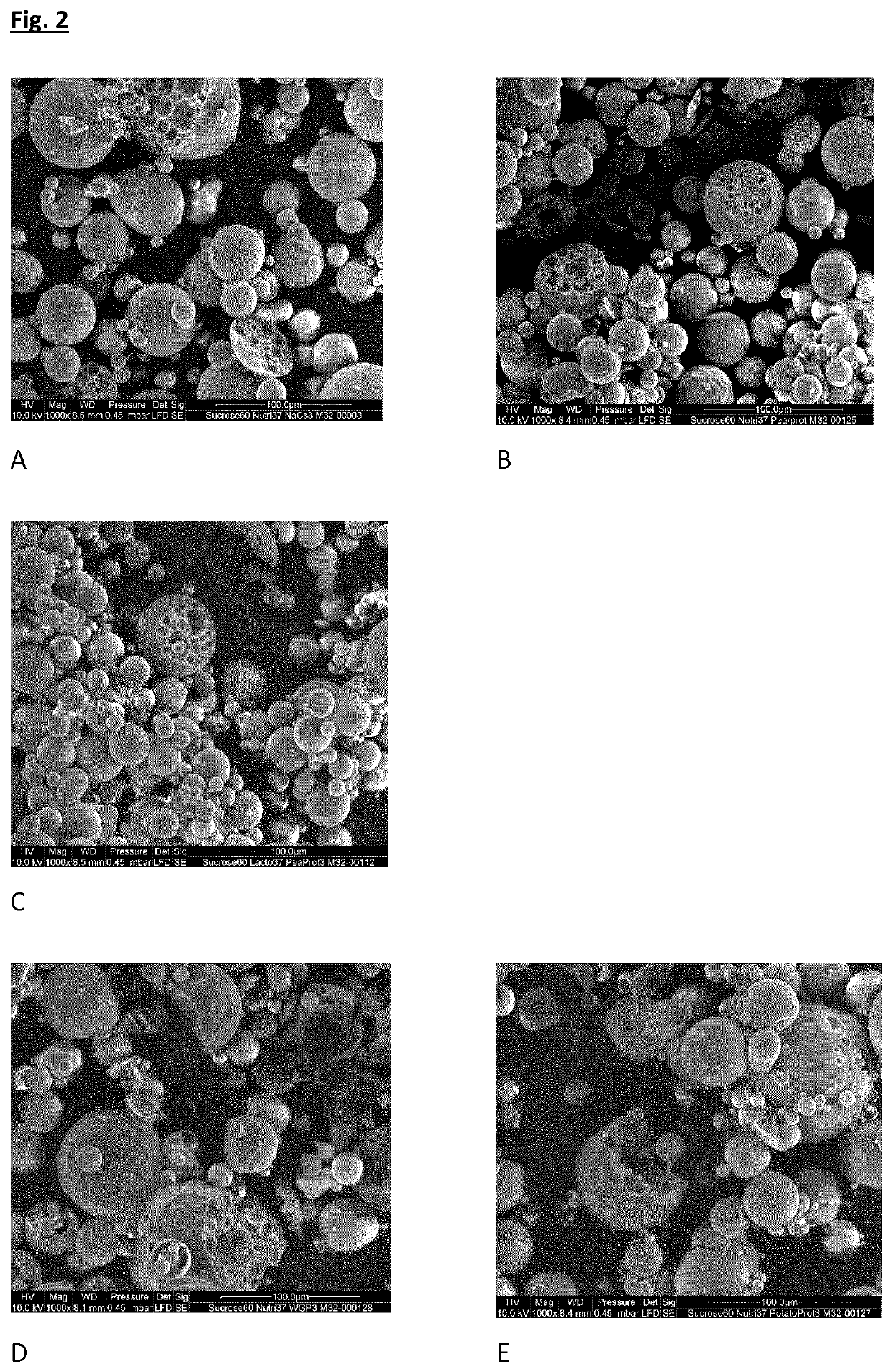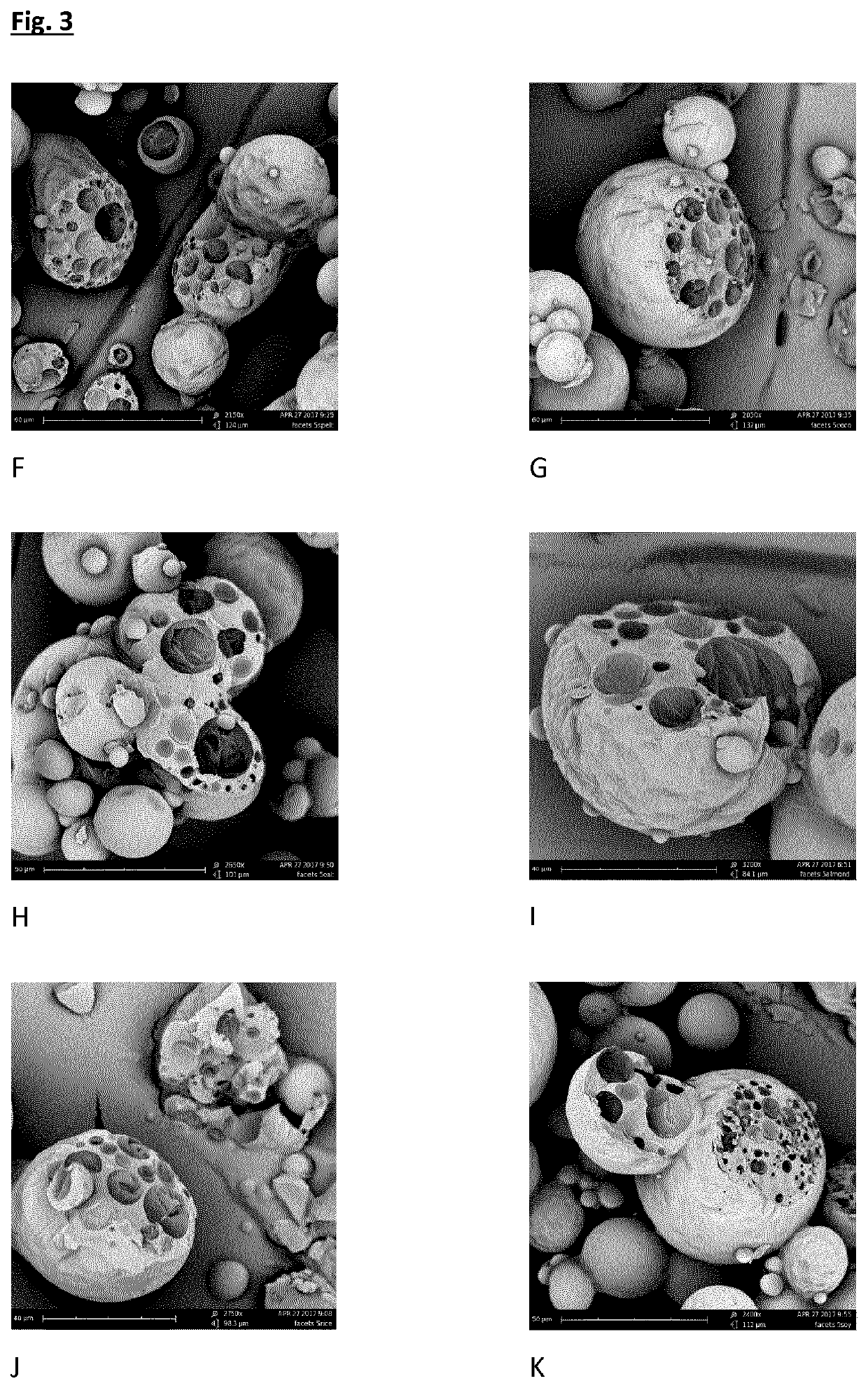Porous particles for reducing sugar in food
a technology of porous particles and food, applied in the field of porous particles, can solve the problems of reducing sweetness, affecting flavour, and other taste components, and reducing sweetness, replacing or reducing sugar in a food composition usually negatively affects the flavour,
- Summary
- Abstract
- Description
- Claims
- Application Information
AI Technical Summary
Benefits of technology
Problems solved by technology
Method used
Image
Examples
example 1
Preparation of the Amorphous Porous Particles with Non-Dairy Proteins
[0167]Three non-dairy proteins from different origins (vegetable, carbohydrate, grains) were tested as components of amorphous porous powders:[0168]Pea protein[0169]Potato protein[0170]Wheat gluten protein.
[0171]Foamability tests were performed in order to check if the proteins will allow the formation of small bubbles during spray-drying. Each protein was dissolved at 3% in water. Sodium caseinate was used as a reference.
[0172]FIG. 1 shows the foams produced. After 30 seconds of mixing all proteins produced foams (FIG. 1B). After 45 min standing (FIG. 1C), all foams were still stable. Wheat gluten and potato proteins produced more stable foams than the reference with sodium caseinate (NaCas).
[0173]Wheat gluten protein, pea protein and potato protein were then used to prepare amorphous porous powders at a level of 3 wt. %. The other components were 60 wt. % sucrose and 37 wt. % Nutriose® (a plant-based fibre from R...
example 2
Preparation of the Amorphous Porous Particles with Plant Milks
[0182]Plant milks were combined with maltodextrin (DE12-20) and sucrose so that, on a solids basis there was 5% plant milk, 35% maltodextrin and 60% sucrose. The mixtures were made up with water at a total solids level of 50% and spray dried with gas injection. All variants are successfully produced with a throughput of 10-12 L / h.
[0183]Physical and chemical characterization of the powders was performed. Results of moisture, glass transition and water activity are presented below.
[0184]
Mois-tureTgaw[%][° C.][—]F60% Sucrose, 35% maltodextrin, 5% Spelt milk3.2645.40.168G60% Sucrose, 35% maltodextrin,3.0347.30.1665% Coconut milkH60% Sucrose, 35% maltodextrin, 5% Oat milk3.4542.10.194I60% Sucrose, 35% maltodextrin,3.2245.60.1775% Almond milkJ60% Sucrose, 35% maltodextrin, 5% Rice milk3.4043.20.187K60% Sucrose, 35% maltodextrin, 5% Soya milk3.6842.00.203
[0185]Results of particle properties are shown below.
[0186]Changing the pla...
example 3
[0189]The kinetics of dissolution of five of the amorphous porous powders was measured and compared to that of a porous amorphous powder manufactured in the same manner, but with 60% sucrose and 40% skimmed milk (bovine) on a solids basis (Ref3). The samples assessed were lactose and pea (C), Nutriose® and wheat gluten (D), maltodextrin and almond milk (I), maltodextrin and coconut milk (G) and maltodextrin and soya milk (K). The results are plotted in FIG. 4. The powder with sucrose, almond milk and maltodextrin has a much faster dissolution that that of sucrose and skimmed milk. Both powders having a similar particle size. Faster dissolution of sweet tasting materials has been shown to correlate with increased sweetness perception.
PUM
 Login to View More
Login to View More Abstract
Description
Claims
Application Information
 Login to View More
Login to View More - R&D
- Intellectual Property
- Life Sciences
- Materials
- Tech Scout
- Unparalleled Data Quality
- Higher Quality Content
- 60% Fewer Hallucinations
Browse by: Latest US Patents, China's latest patents, Technical Efficacy Thesaurus, Application Domain, Technology Topic, Popular Technical Reports.
© 2025 PatSnap. All rights reserved.Legal|Privacy policy|Modern Slavery Act Transparency Statement|Sitemap|About US| Contact US: help@patsnap.com



